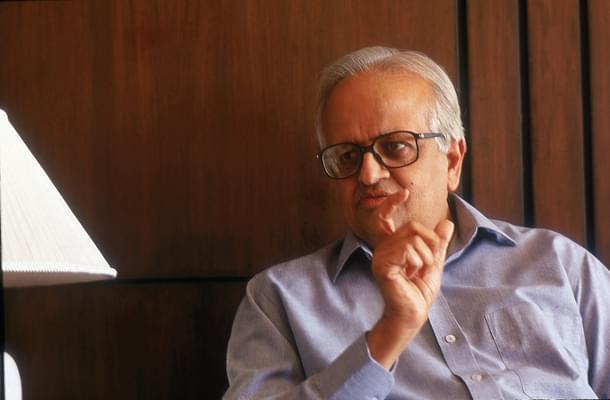Economics
What Happens If The Jalan Committee Endorses The Transfer Of RBI’s Surplus Reserves To The Government?
Jayant Mundhra
Jun 12, 2019, 04:06 PM | Updated 04:06 PM IST
Save & read from anywhere!
Bookmark stories for easy access on any device or the Swarajya app.


It was sometime between November and December 2018 when a perceived rift between the then Reserve Bank of India (RBI) governor, Urjit Patel, and the Government of India had given wings to the media houses to accuse the central government of pushing an independent RBI to transfer a share of its surplus contingency reserves to the government's coffers.
The news turned out to be a misleading one, as the government had not asked the RBI to transfer any surplus reserves. What it had indeed asked the central bank to do was to present a rationale regarding the amount of reserves the RBI really needed. This information was elicited because, while the central bank was holding a surplus contingency reserve to the tune of 27-28 per cent of the net assets held by it, the global average for the economies of our size and scale was (and still is) about 14 per cent.
Some background on RBI’s excess contingency reserves
The issue about RBI holding excess contingency reserves also gained significance because three committees on RBI’s Economic Capital Framework — each appointed by the RBI itself in the past — had opined that the RBI had been holding far too much of excess reserves. Of these, the V Subrahmanyam committee, instituted in 1997, had recommended that contingency reserves should be built up to 12 per cent, while the Usha Thorat committee, instituted later in 2004, had recommended that the reserves should be maintained at 18 per cent of the total assets.
The same issue had also been raised by two former chief economic advisors to the Government of India — Raghuram Rajan and Arvind Subramanian. Rajan had gone to the extent of writing a letter to the then RBI governor, D Subbarao, to consider transferring the excess reserves to the government so that the sum could be infused into the economy towards building quality infrastructure, which was (and still is) lacking in India.
Thus, the RBI holding excess reserves for contingencies is not a new event and it only got renewed attention when the central government in 2018 built pressure over the RBI to present a rationale about how much of the surplus reserves it required for itself.
As a result, on 26 December 2018, the central bank, under its newly appointed governor, Shaktikanta Das, yet again constituted an expert committee to deliberate on the Economic Capital Framework of the RBI. It was to be headed by former RBI governor, Bimal Jalan. The committee was asked to particularly analyse and answer once and for all, how much of the reserves the RBI is required to hold, keeping the worst-case scenario in mind — like a recession or an exchange rate crash or a sudden spike in oil prices or some other economic eventuality difficult to predict.
The committee was supposed to submit its report in 90 days from the day of its first meeting (which happened in January 2019) but was later given an extension and is now set to submit its report by the end of June 2019.
Cause for excitement
Now, what creates excitement, as the end of June nears, is the growing likelihood of the Bimal Jalan committee to conclude — along with the narratives and observations of the previous such committees — that the RBI has been sitting on too much of surplus reserves. It is also expected that the committee would recommend the RBI to transfer that excess sum to the Government of India.
Some estimates have suggested that this amount could be as much as Rs 1-2 lakh crore. According to a report by Bank of America Merrill Lynch, the committee is likely to identify an excess buffer of up to Rs 3 lakh crore. That is a ginormous sum of money! So, the question that arises here is what will the government do with this remarkable sum of money? Would it use it prudently or squander it off frivolously? And, that is where my excitement finds its roots.
Should this money be allotted to infrastructure building? Should it be channelled into stressed public sector banks (PSBs) to recapitalise them? Should it be spent on welfare schemes to address the ongoing rural distress and subdued consumption in the economy? Or should it be used to create a well-funded Asset Management Company (AMC)?
Among these suggestions, the one idea that seems to have found tremendous acceptance in the policy circles is the one to channel the large pool of money into the stressed PSBs to get them recapitalised. The rationale behind this idea is to flush the cash-strapped and NPA-ridden PSBs with enough money, so that they could then lend more comfortably to industries — big and small, MSMEs, infrastructure projects and all other lending domains — to fire-up the engines of growth and employment generation to the fullest.
Furthermore, as of this date, five PSBs remain under the RBI's stringent Prompt Corrective Action (PCA) protocols. Infusing fresh funds into these banks would help the government to bring these banks out of the clutches of the PCA, post which they too could join the lending boom with their peer PSBs to help boost economic activity within the country.
While that sounds like music to our ears, history tells us to think again and think wisely.
Massive NPAs created post global recession of 2008
Post the global recession of 2008, when the Federal Reserve of the United States (US) had initiated its Quantitative Easing Programme — owing to higher interest rates in India and lower interest rates in the US— large volumes of US dollars had come into India looking for better returns. Indian banks were flush with a large amount of such money. What happened next was disastrous; the PSBs went berserk, lending recklessly during the period between 2009 and 2012, which led to the current NPA and twin-balance sheet crisis that the Indian economy is still grappling with and striving to recuperate from.
The struggle to extricate our economy from the NPA issue is still far from over despite numerous measures deployed by the government including the famed Insolvency and Bankruptcy Code (IBC) and the biggest ever bank recapitalisation exercise in independent India, under which the PSBs received a whopping Rs 2.16 trillion from the central government’s coffers.
Considering all of this, what are the guarantees that the PSBs won't go on a reckless lending spree again with such a large amount of money in their possession? If these PSBs would yet again go on to lend this money from the RBI's extant reserves with zero integrity and jurisprudence, it could mark the beginning of another list of NPAs that will thwart another decade of potential growth for India. Can we really afford this after all that we have been through as an economy over the past decade?
This fear and caution form the case for considering another idea.
A case for instituting an Asset Management Company
How about instituting a well-funded Asset Management Company (AMC)? Such a company could take over the stuck infrastructure NPAs from the PSBs and bugged NBFCs like IL&FS, and get them going with the new funding.
Not only would this ensure a big infrastructure boom with the manifestation of a host of large scale and long overdue projects, it would also relieve the PSBs of their infrastructure NPA portfolios that they had lent to in the past during the lending boom. By subverting the risk of another lending fiasco as it happened in the 2009-12 period, banks could grow out of the NPA crisis organically through reforms, returns from the IBC and adoption of better risk assessment strategies. Otherwise through a PSB recapitalisation drive we could end up giving birth to another NPA crisis, while also drying up the exchequer.
We will soon know what way the government will finally choose to go given that the outcomes from the Bimal Jalan Committee deliberations will soon be before us all. That is when the RBI, Ministry of Finance, NITI Aayog and the Cabinet Committee on Economic Affairs (CCEA) will take the final decision on which path to tread.
However, all of that will happen only if the committee concludes that RBI has an excess of contingency reserves that should be transferred to the government of India.
Will it? And, if it does, what will happen next? We will know soon enough.




